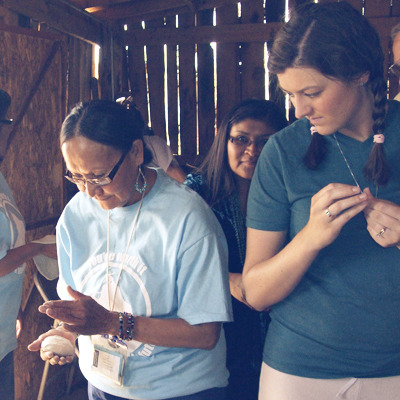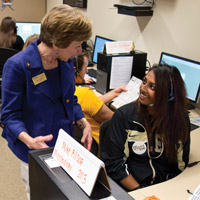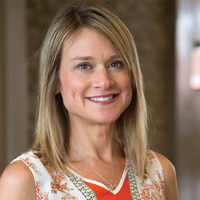Living and learning in the Navajo Nation

Nursing student Danielle Simpson observes how to make a tortilla. (Photo provided by Pam Aaltonen)
The towering rock formations of Utah's Monument Valley provide the backdrop for a unique learning opportunity for Purdue University nursing students. Each May, a select group of seniors travels to the Navajo Nation in northern Arizona to complete their public health nursing clinical experience under the guidance of the Indian Health Service and the Navajo Nation Public Health Nursing Department.
Stationed for two weeks at the Kayenta Health Center, the students work alongside public health nurses to provide care for tribe members living in the Navajo Nation chapters of Chilchinbeto, Dennehotso, Inscription House, Kayenta, Navajo Mountain, Oljato and Shonto. The center services a region of 4,500 square miles and a population of 18,000.
The Kayenta program allows nursing students the opportunity to work with a unique patient population they don't see in the Midwest. They also begin to understand the challenges of delivering health care to a population that lives in remote areas, at times without electricity or running water.
"My biggest takeaway from Kayenta was observing how different the Navajo Nation is from the rest of the United States," says Sarah Eberle, BS '13, a nurse at St. Vincent Hospital in Indianapolis. "The experience helped me recognize the importance and value of culturally competent nursing care. It helps to improve patient-nurse communication and ultimately patient outcomes."
The lesson of how to work with and talk to diverse patient populations is something that can't be taught easily in a classroom, says Pamela Aaltonen, associate head in the School of Nursing at Purdue. She leads the group of four to five nursing students to Kayenta and teaches the public health nursing clinical course students take in their senior year. Although most students complete their public health clinicals in a more traditional setting, Kayenta provides a unique learning opportunity.
"They get to experience working in an environment where they are in the minority rather than the majority and see firsthand the obstacles to delivering health care to a population that lives in remote areas," she says.
Aaltonen adds that diabetes is a challenge for this population, so students learn a tremendous amount about this chronic disease. Students also encounter health issues such as hantavirus, plague and Rift Valley fever that they generally won't see in the Midwest.











